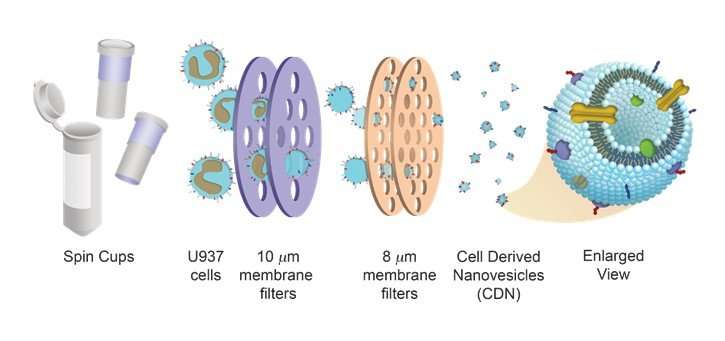Schematic demonstrating the production of CDNs. CDNs can be produced “on-demand” in larger quantities within a shorter time frame than isolating the same amount of exosomes. Credit: National University of Singapore
NUS pharmaceutical scientists have developed a cost-effective method to produce cell-derived nanovesicles (CDNs) for bio-inspired drug delivery applications.
Drug Delivery Systems (DDS) play an important role in transporting drugs to their intended target sites. They protect the active pharmaceutical compounds from the external environment during their journey to the target tissues, resulting in more effective treatment and lower drug amounts. Several synthetic DDS have been developed in recent years, but they are often limited by their accumulation in the body, hence resulting in greater potential toxicity profiles, especially if the drug cannot reach the diseased area in sufficient amounts.
Interestingly, naturally produced nanoscale cellular structures (vesicles), namely exosomes, are released by almost all mammalian cells. Exosomes have emerged as potential candidates for use as DDS due to their low toxicity (in view of their natural origin), ability to house biological cargo and propensity to accumulate within diseased tissue (due to the preservation of key surface features from their parent cells). However, their translation into clinical applications is limited by the multi-step approach needed to isolate naturally secreted exosomes and its low yield.
Prof Giorgia PASTORIN and her Ph.D. student Wei Jiang GOH from the Department of Pharmacy, NUS, have developed a simple and cost-effective method to produce CDNs, which can mimic naturally occurring exosomes. The CDNs are produced by shearing cells into nanoscale vesicles by passing them through a series of filters using standard laboratory equipment. These CDNs have been shown to be similar to exosomes in terms of key proteins and lipid composition. Using this new method, CDNs can be produced "on demand" and in larger quantities as compared to isolating exosomes from the same amount of cells.
Prof Pastorin said, "We have demonstrated that these CDNs retain the ability to reach and accumulate at cancerous tissue in a mouse tumour model and have developed a method for loading a chemotherapeutic drug into the CDNs."
More information: Wei Jiang Goh et al. Bioinspired Cell-Derived Nanovesicles versus Exosomes as Drug Delivery Systems: a Cost-Effective Alternative, Scientific Reports (2017). DOI: 10.1038/s41598-017-14725-x
Wei Jiang Goh et al. Doxorubicin-loaded cell-derived nanovesicles: an alternative targeted approach for anti-tumor therapy, International Journal of Nanomedicine (2017). DOI: 10.2147/IJN.S131786
Journal information: Scientific Reports
Provided by National University of Singapore























